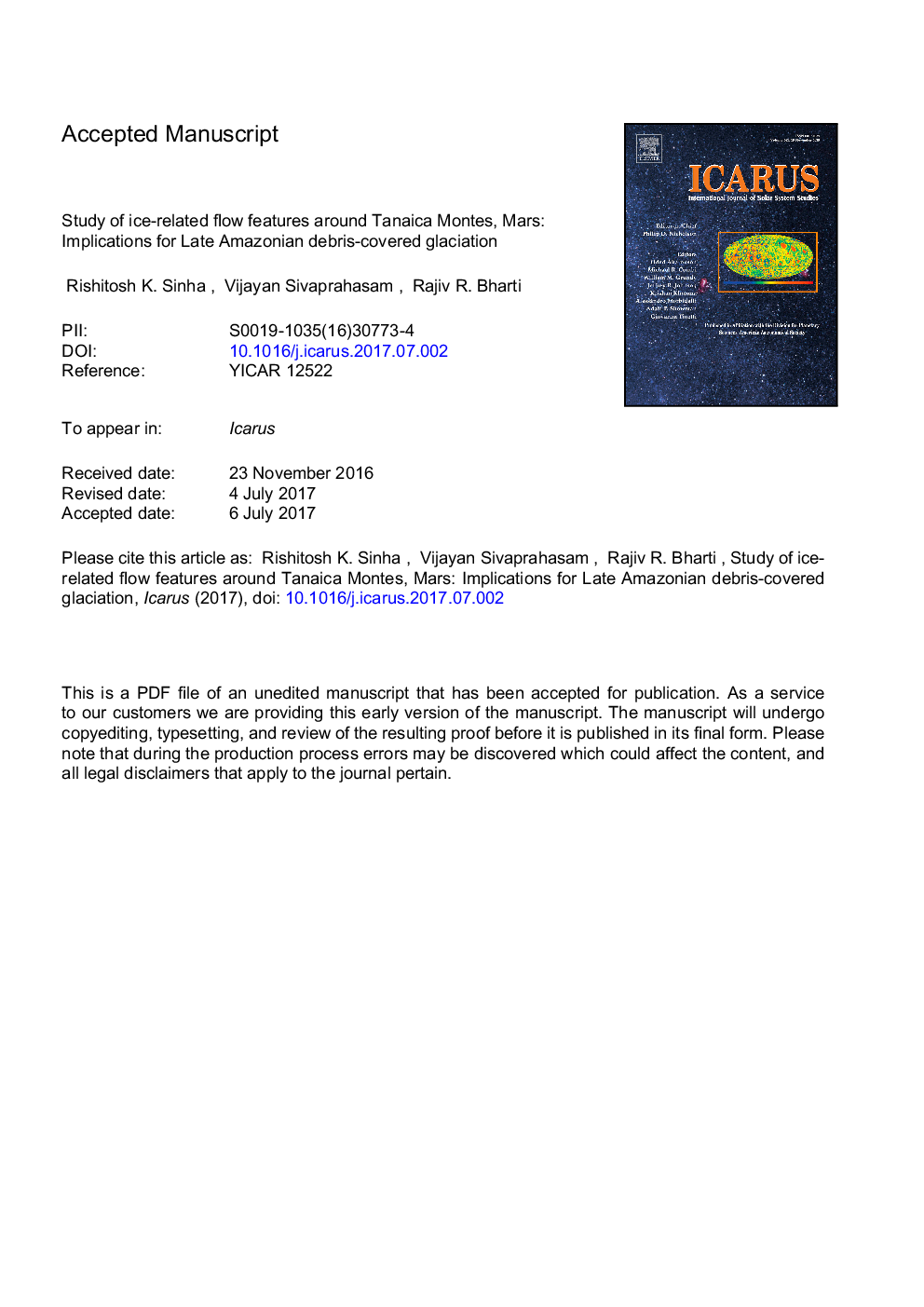| کد مقاله | کد نشریه | سال انتشار | مقاله انگلیسی | نسخه تمام متن |
|---|---|---|---|---|
| 5487180 | 1523494 | 2017 | 79 صفحه PDF | دانلود رایگان |
عنوان انگلیسی مقاله ISI
Study of ice-related flow features around Tanaica Montes, Mars: Implications for late amazonian debris-covered glaciation
دانلود مقاله + سفارش ترجمه
دانلود مقاله ISI انگلیسی
رایگان برای ایرانیان
موضوعات مرتبط
مهندسی و علوم پایه
علوم زمین و سیارات
علوم فضا و نجوم
پیش نمایش صفحه اول مقاله

چکیده انگلیسی
Lobate debris aprons (LDA) and lineated valley fill (LVF) have been broadly recognized in the mid-latitudes of Mars and their subsequent analyses using data from the SHAllow RADar (SHARAD) instrument has suggested evidence for contemporary ice preserved beneath these features. In this study, we conduct detailed characterization of newly identified LDA flow units within the Tanaica Montes region (39.55Ë N, 269.17Ë E) of Mars to assess and understand the similarities in their emplacement with respect to LDA flow units mapped in other regions of Mars. We utilize the Mars Reconnaissance Orbiter (MRO) Context Camera (CTX) images and SHAllow RADar (SHARAD) datasets for geomorphic and subsurface analysis and Mars Global Surveyor (MGS) Mars Orbiter Laser Altimeter (MOLA) point tracks for topographic analysis. Geomorphic observation of LDA flow units surrounding the montes flanks and massif walls reveal integrated pattern of convergence and divergence and evidence of bending and deflection within the flow lines that resulted in concentric, loop-like flow patterns in the downslope. Brain-terrain texture and craters with varying morphological characteristics (ring-mold type) is suggestive that LDAs may be similar to ice-rich, debris-covered glaciers. MOLA point track based convex-up topographic profiles of LDAs suggest that their thickness vary in the range of â¼100-200â¯m in both the northwestern and southeastern portions of study region. Further, the slope values of mapped LDA surfaces within the study region are within â¼0.1Ë-4Ë. The extent of mapped LDAs within the study region is such that some of the low elevation (â¼0.8-1.3â¯km) portions of montes flanks are surrounded by relatively less extent (up to â¼0.5-0.8â¯km) of LDA flow units. Geomorphic and topographic evidence for flow units that appear to be superposed on the main LDA body collectively suggest the possibility of episodic glacial activity in the region. Furthermore, based on the alignment of subsurface reflectors with the surrounding plains when a permittivity of ice (3.2) is assumed and the radargram is depth-corrected, we infer that some of the portions of LDA flow units have preserved ice in their subsurface up to â¼300-500â¯m depth. Crater size frequency distribution of craters counted on LDA surface indicates that the best-fit age is â¼110 Ma. In addition, the LDA surfaces exhibit different best-fit ages for different types of crater morphologies (bowl-shaped, ring-mold and infilled craters) included in the crater count statistics. Together, these observations and the interpretations suggest that most, if not all, of the LDAs in the study region are like classical LDAs mapped in other regions of Mars (e.g. along the mid-latitude dichotomy boundary and eastern Hellas region). These results indicate that a widespread accumulation and preservation of ice has occurred during the Late Amazonian as suggested in previous studies.
ناشر
Database: Elsevier - ScienceDirect (ساینس دایرکت)
Journal: Icarus - Volume 297, 15 November 2017, Pages 217-239
Journal: Icarus - Volume 297, 15 November 2017, Pages 217-239
نویسندگان
Rishitosh K. Sinha, S. Vijayan, Rajiv R. Bharti,